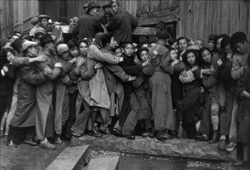Through the end of 1935, Cartier-Bresson developed his own film and made his own prints. However, some of his best photographs of the period were not printed until his first museum exhibition, at the Museum of Modern Art (MoMA) in 1947—by which time he was no longer making prints. Cartier-Bresson loved exploring the world through photography, but he had no interest in darkroom work. That inclination dovetailed with the norms of photojournalism: what mattered was not the print but the image, which was selected, captioned, cropped, and positioned on the page by editors and designers. Though Cartier-Bresson tried to insist that his captions be respected and his pictures remain uncropped, like other photographers, he generally had little say in the matter.
In Paris in 1950 Cartier-Bresson’s friend Pierre Gassmann founded Pictorial Service, a lab that ultimately produced virtually all of his prints. Magazines and newspapers maintained their own darkrooms, however, and for urgent assignments, sets of his prints might be produced in New York, London, and Paris before the negatives were filed at Pictorial Service. As a result, the history of Cartier-Bresson prints made for reproduction is very complex, and serious study of it has barely begun.
Although color photography was part of photojournalism throughout his career and his color pictures regularly appeared in magazines, he never became comfortable with the medium and ultimately excluded color pictures from what he regarded as his life’s work.
Henri Cartier-Bresson. Shanghai, China, 1948. The Museum of Modern Art, New York. Acquired through the generosity of Robert B. Menschel. © 2010 Henri Cartier-Bresson / Magnum Photos, courtesy Fondation Henri Cartier-Bresson.

